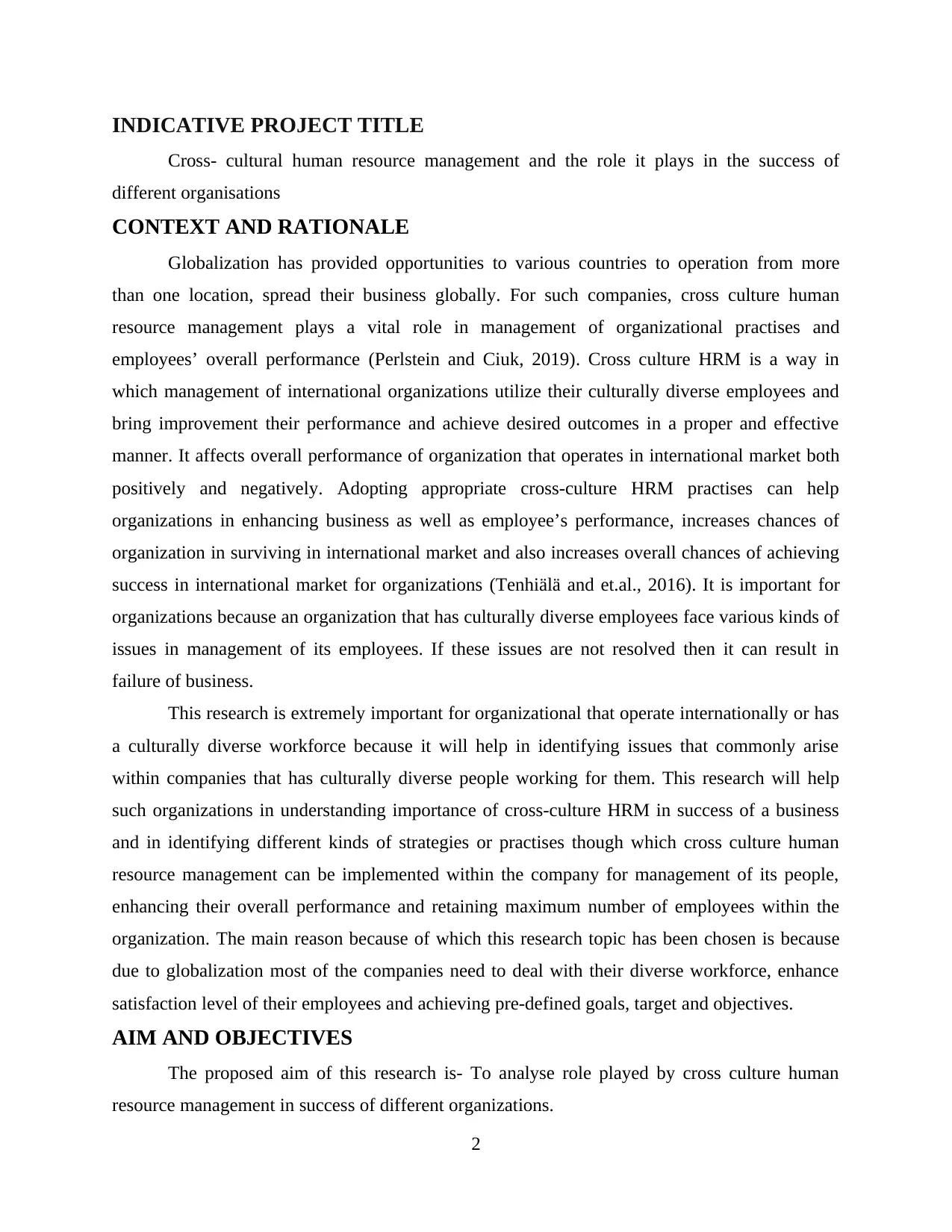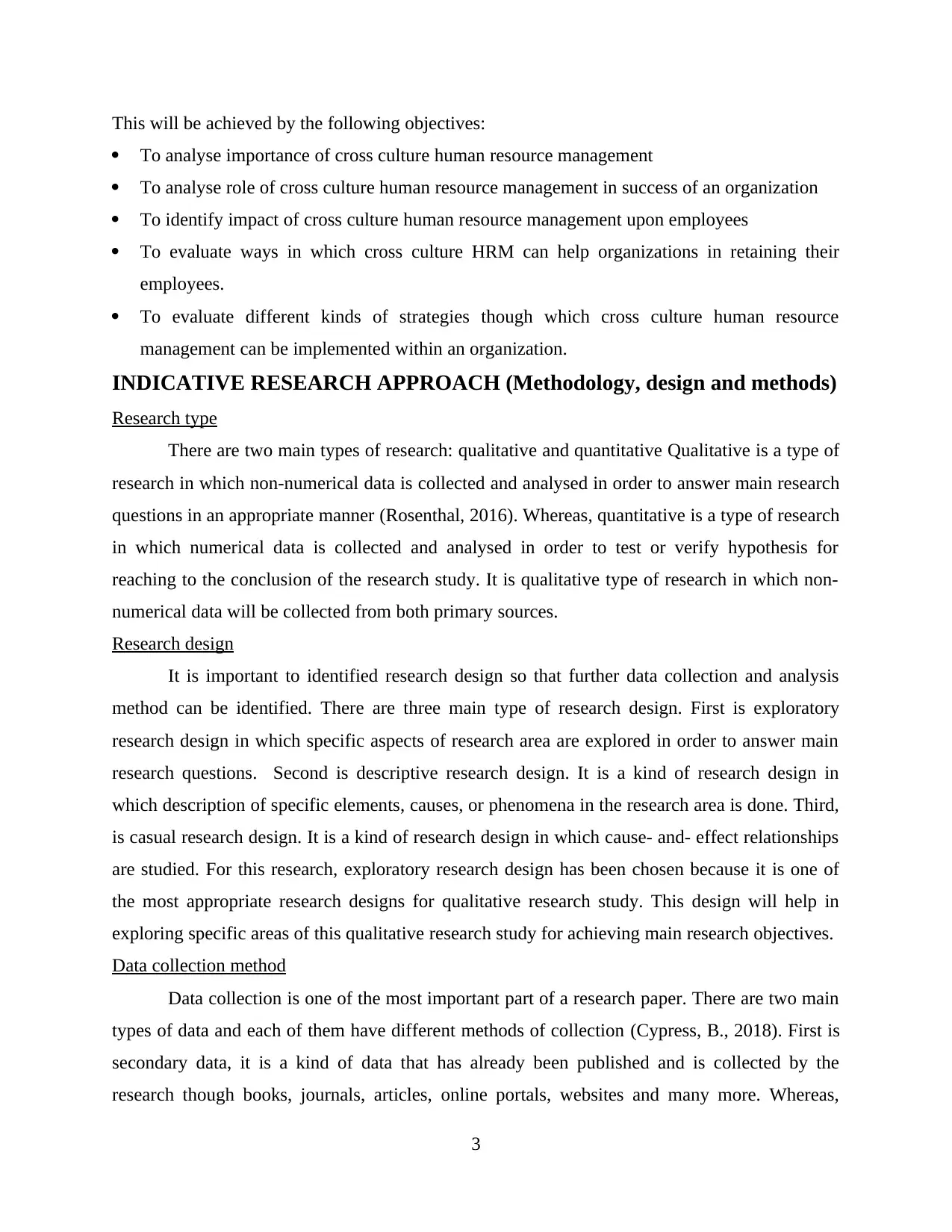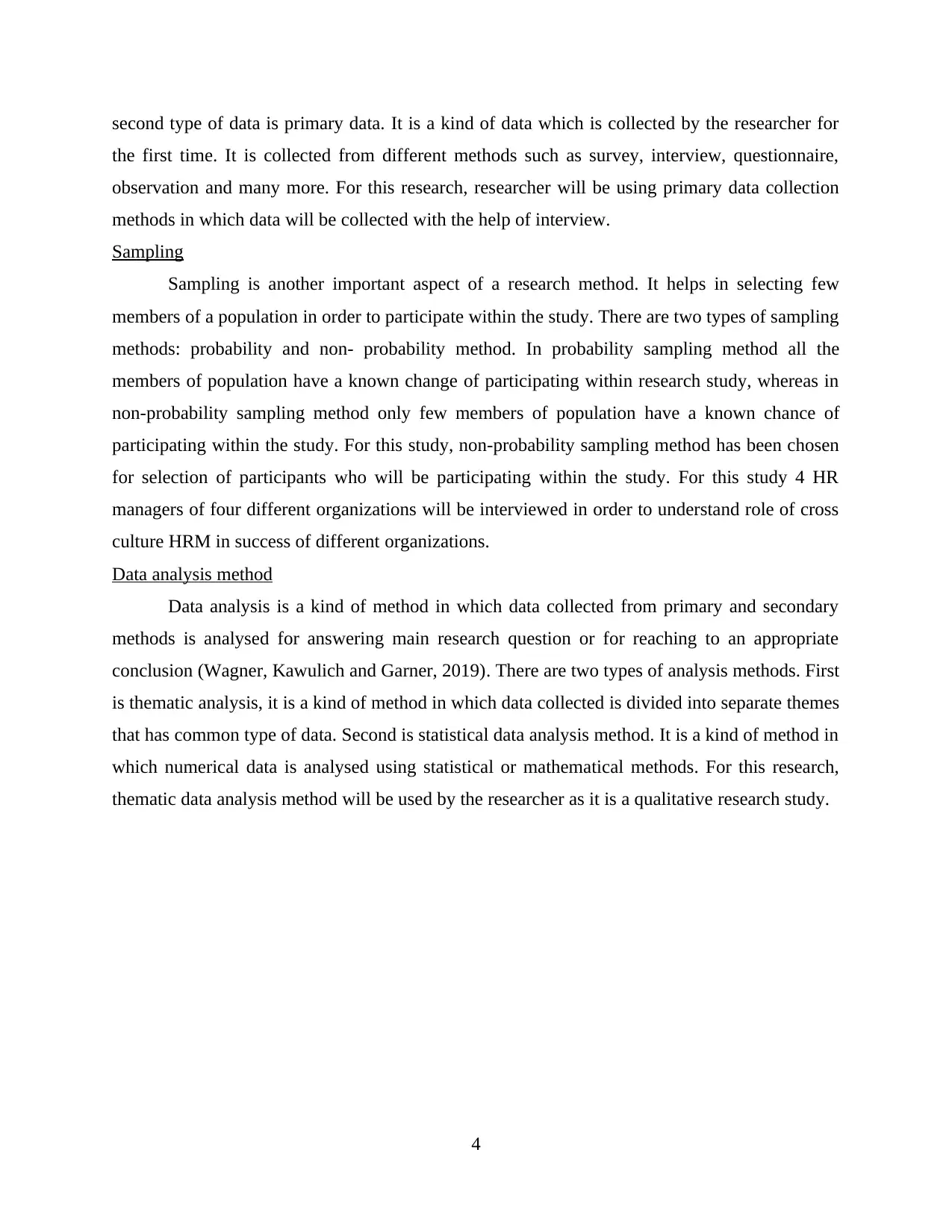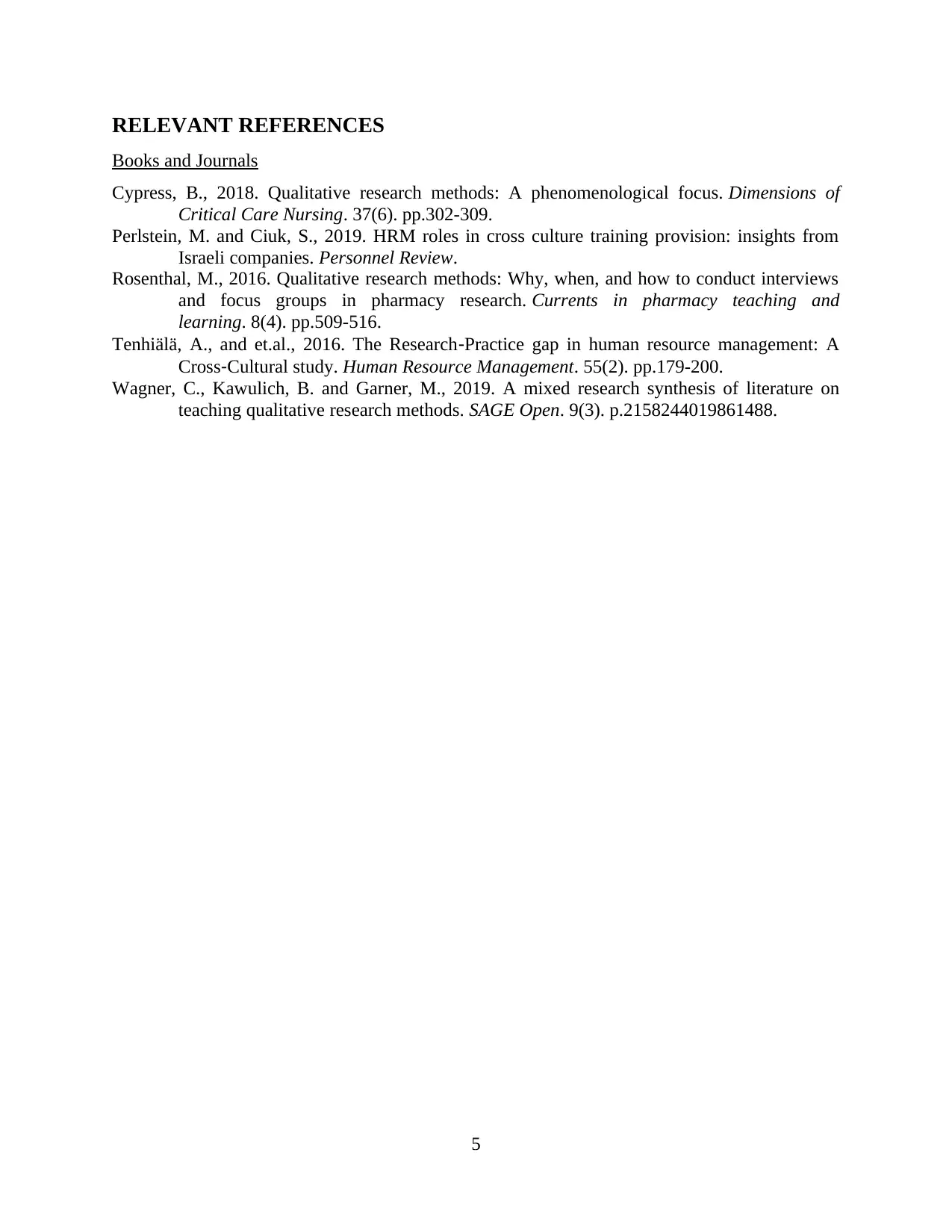Analysis of Cross-Cultural Human Resource Management in Organizations
VerifiedAdded on 2023/01/06
|5
|1292
|45
Report
AI Summary
This report presents a research proposal focusing on cross-cultural human resource management (HRM) and its role in organizational success. The context highlights the increasing importance of cross-cultural HRM due to globalization and the management of diverse workforces. The research aims to analyze the impact of cross-cultural HRM on organizational success, employee performance, and retention. It will explore the importance of cross-cultural HRM, its impact on employees, and strategies for implementation. The research will employ a qualitative approach using exploratory research design, collecting primary data through interviews with HR managers. Thematic analysis will be used to analyze the collected data. The report also includes a review of relevant literature and references.

RESEARCH TEMPLATE
1
1
Paraphrase This Document
Need a fresh take? Get an instant paraphrase of this document with our AI Paraphraser

INDICATIVE PROJECT TITLE
Cross- cultural human resource management and the role it plays in the success of
different organisations
CONTEXT AND RATIONALE
Globalization has provided opportunities to various countries to operation from more
than one location, spread their business globally. For such companies, cross culture human
resource management plays a vital role in management of organizational practises and
employees’ overall performance (Perlstein and Ciuk, 2019). Cross culture HRM is a way in
which management of international organizations utilize their culturally diverse employees and
bring improvement their performance and achieve desired outcomes in a proper and effective
manner. It affects overall performance of organization that operates in international market both
positively and negatively. Adopting appropriate cross-culture HRM practises can help
organizations in enhancing business as well as employee’s performance, increases chances of
organization in surviving in international market and also increases overall chances of achieving
success in international market for organizations (Tenhiälä and et.al., 2016). It is important for
organizations because an organization that has culturally diverse employees face various kinds of
issues in management of its employees. If these issues are not resolved then it can result in
failure of business.
This research is extremely important for organizational that operate internationally or has
a culturally diverse workforce because it will help in identifying issues that commonly arise
within companies that has culturally diverse people working for them. This research will help
such organizations in understanding importance of cross-culture HRM in success of a business
and in identifying different kinds of strategies or practises though which cross culture human
resource management can be implemented within the company for management of its people,
enhancing their overall performance and retaining maximum number of employees within the
organization. The main reason because of which this research topic has been chosen is because
due to globalization most of the companies need to deal with their diverse workforce, enhance
satisfaction level of their employees and achieving pre-defined goals, target and objectives.
AIM AND OBJECTIVES
The proposed aim of this research is- To analyse role played by cross culture human
resource management in success of different organizations.
2
Cross- cultural human resource management and the role it plays in the success of
different organisations
CONTEXT AND RATIONALE
Globalization has provided opportunities to various countries to operation from more
than one location, spread their business globally. For such companies, cross culture human
resource management plays a vital role in management of organizational practises and
employees’ overall performance (Perlstein and Ciuk, 2019). Cross culture HRM is a way in
which management of international organizations utilize their culturally diverse employees and
bring improvement their performance and achieve desired outcomes in a proper and effective
manner. It affects overall performance of organization that operates in international market both
positively and negatively. Adopting appropriate cross-culture HRM practises can help
organizations in enhancing business as well as employee’s performance, increases chances of
organization in surviving in international market and also increases overall chances of achieving
success in international market for organizations (Tenhiälä and et.al., 2016). It is important for
organizations because an organization that has culturally diverse employees face various kinds of
issues in management of its employees. If these issues are not resolved then it can result in
failure of business.
This research is extremely important for organizational that operate internationally or has
a culturally diverse workforce because it will help in identifying issues that commonly arise
within companies that has culturally diverse people working for them. This research will help
such organizations in understanding importance of cross-culture HRM in success of a business
and in identifying different kinds of strategies or practises though which cross culture human
resource management can be implemented within the company for management of its people,
enhancing their overall performance and retaining maximum number of employees within the
organization. The main reason because of which this research topic has been chosen is because
due to globalization most of the companies need to deal with their diverse workforce, enhance
satisfaction level of their employees and achieving pre-defined goals, target and objectives.
AIM AND OBJECTIVES
The proposed aim of this research is- To analyse role played by cross culture human
resource management in success of different organizations.
2

This will be achieved by the following objectives:
To analyse importance of cross culture human resource management
To analyse role of cross culture human resource management in success of an organization
To identify impact of cross culture human resource management upon employees
To evaluate ways in which cross culture HRM can help organizations in retaining their
employees.
To evaluate different kinds of strategies though which cross culture human resource
management can be implemented within an organization.
INDICATIVE RESEARCH APPROACH (Methodology, design and methods)
Research type
There are two main types of research: qualitative and quantitative Qualitative is a type of
research in which non-numerical data is collected and analysed in order to answer main research
questions in an appropriate manner (Rosenthal, 2016). Whereas, quantitative is a type of research
in which numerical data is collected and analysed in order to test or verify hypothesis for
reaching to the conclusion of the research study. It is qualitative type of research in which non-
numerical data will be collected from both primary sources.
Research design
It is important to identified research design so that further data collection and analysis
method can be identified. There are three main type of research design. First is exploratory
research design in which specific aspects of research area are explored in order to answer main
research questions. Second is descriptive research design. It is a kind of research design in
which description of specific elements, causes, or phenomena in the research area is done. Third,
is casual research design. It is a kind of research design in which cause- and- effect relationships
are studied. For this research, exploratory research design has been chosen because it is one of
the most appropriate research designs for qualitative research study. This design will help in
exploring specific areas of this qualitative research study for achieving main research objectives.
Data collection method
Data collection is one of the most important part of a research paper. There are two main
types of data and each of them have different methods of collection (Cypress, B., 2018). First is
secondary data, it is a kind of data that has already been published and is collected by the
research though books, journals, articles, online portals, websites and many more. Whereas,
3
To analyse importance of cross culture human resource management
To analyse role of cross culture human resource management in success of an organization
To identify impact of cross culture human resource management upon employees
To evaluate ways in which cross culture HRM can help organizations in retaining their
employees.
To evaluate different kinds of strategies though which cross culture human resource
management can be implemented within an organization.
INDICATIVE RESEARCH APPROACH (Methodology, design and methods)
Research type
There are two main types of research: qualitative and quantitative Qualitative is a type of
research in which non-numerical data is collected and analysed in order to answer main research
questions in an appropriate manner (Rosenthal, 2016). Whereas, quantitative is a type of research
in which numerical data is collected and analysed in order to test or verify hypothesis for
reaching to the conclusion of the research study. It is qualitative type of research in which non-
numerical data will be collected from both primary sources.
Research design
It is important to identified research design so that further data collection and analysis
method can be identified. There are three main type of research design. First is exploratory
research design in which specific aspects of research area are explored in order to answer main
research questions. Second is descriptive research design. It is a kind of research design in
which description of specific elements, causes, or phenomena in the research area is done. Third,
is casual research design. It is a kind of research design in which cause- and- effect relationships
are studied. For this research, exploratory research design has been chosen because it is one of
the most appropriate research designs for qualitative research study. This design will help in
exploring specific areas of this qualitative research study for achieving main research objectives.
Data collection method
Data collection is one of the most important part of a research paper. There are two main
types of data and each of them have different methods of collection (Cypress, B., 2018). First is
secondary data, it is a kind of data that has already been published and is collected by the
research though books, journals, articles, online portals, websites and many more. Whereas,
3
⊘ This is a preview!⊘
Do you want full access?
Subscribe today to unlock all pages.

Trusted by 1+ million students worldwide

second type of data is primary data. It is a kind of data which is collected by the researcher for
the first time. It is collected from different methods such as survey, interview, questionnaire,
observation and many more. For this research, researcher will be using primary data collection
methods in which data will be collected with the help of interview.
Sampling
Sampling is another important aspect of a research method. It helps in selecting few
members of a population in order to participate within the study. There are two types of sampling
methods: probability and non- probability method. In probability sampling method all the
members of population have a known change of participating within research study, whereas in
non-probability sampling method only few members of population have a known chance of
participating within the study. For this study, non-probability sampling method has been chosen
for selection of participants who will be participating within the study. For this study 4 HR
managers of four different organizations will be interviewed in order to understand role of cross
culture HRM in success of different organizations.
Data analysis method
Data analysis is a kind of method in which data collected from primary and secondary
methods is analysed for answering main research question or for reaching to an appropriate
conclusion (Wagner, Kawulich and Garner, 2019). There are two types of analysis methods. First
is thematic analysis, it is a kind of method in which data collected is divided into separate themes
that has common type of data. Second is statistical data analysis method. It is a kind of method in
which numerical data is analysed using statistical or mathematical methods. For this research,
thematic data analysis method will be used by the researcher as it is a qualitative research study.
4
the first time. It is collected from different methods such as survey, interview, questionnaire,
observation and many more. For this research, researcher will be using primary data collection
methods in which data will be collected with the help of interview.
Sampling
Sampling is another important aspect of a research method. It helps in selecting few
members of a population in order to participate within the study. There are two types of sampling
methods: probability and non- probability method. In probability sampling method all the
members of population have a known change of participating within research study, whereas in
non-probability sampling method only few members of population have a known chance of
participating within the study. For this study, non-probability sampling method has been chosen
for selection of participants who will be participating within the study. For this study 4 HR
managers of four different organizations will be interviewed in order to understand role of cross
culture HRM in success of different organizations.
Data analysis method
Data analysis is a kind of method in which data collected from primary and secondary
methods is analysed for answering main research question or for reaching to an appropriate
conclusion (Wagner, Kawulich and Garner, 2019). There are two types of analysis methods. First
is thematic analysis, it is a kind of method in which data collected is divided into separate themes
that has common type of data. Second is statistical data analysis method. It is a kind of method in
which numerical data is analysed using statistical or mathematical methods. For this research,
thematic data analysis method will be used by the researcher as it is a qualitative research study.
4
Paraphrase This Document
Need a fresh take? Get an instant paraphrase of this document with our AI Paraphraser

RELEVANT REFERENCES
Books and Journals
Cypress, B., 2018. Qualitative research methods: A phenomenological focus. Dimensions of
Critical Care Nursing. 37(6). pp.302-309.
Perlstein, M. and Ciuk, S., 2019. HRM roles in cross culture training provision: insights from
Israeli companies. Personnel Review.
Rosenthal, M., 2016. Qualitative research methods: Why, when, and how to conduct interviews
and focus groups in pharmacy research. Currents in pharmacy teaching and
learning. 8(4). pp.509-516.
Tenhiälä, A., and et.al., 2016. The Research‐Practice gap in human resource management: A
Cross‐Cultural study. Human Resource Management. 55(2). pp.179-200.
Wagner, C., Kawulich, B. and Garner, M., 2019. A mixed research synthesis of literature on
teaching qualitative research methods. SAGE Open. 9(3). p.2158244019861488.
5
Books and Journals
Cypress, B., 2018. Qualitative research methods: A phenomenological focus. Dimensions of
Critical Care Nursing. 37(6). pp.302-309.
Perlstein, M. and Ciuk, S., 2019. HRM roles in cross culture training provision: insights from
Israeli companies. Personnel Review.
Rosenthal, M., 2016. Qualitative research methods: Why, when, and how to conduct interviews
and focus groups in pharmacy research. Currents in pharmacy teaching and
learning. 8(4). pp.509-516.
Tenhiälä, A., and et.al., 2016. The Research‐Practice gap in human resource management: A
Cross‐Cultural study. Human Resource Management. 55(2). pp.179-200.
Wagner, C., Kawulich, B. and Garner, M., 2019. A mixed research synthesis of literature on
teaching qualitative research methods. SAGE Open. 9(3). p.2158244019861488.
5
1 out of 5
Related Documents
Your All-in-One AI-Powered Toolkit for Academic Success.
+13062052269
info@desklib.com
Available 24*7 on WhatsApp / Email
![[object Object]](/_next/static/media/star-bottom.7253800d.svg)
Unlock your academic potential
Copyright © 2020–2025 A2Z Services. All Rights Reserved. Developed and managed by ZUCOL.




